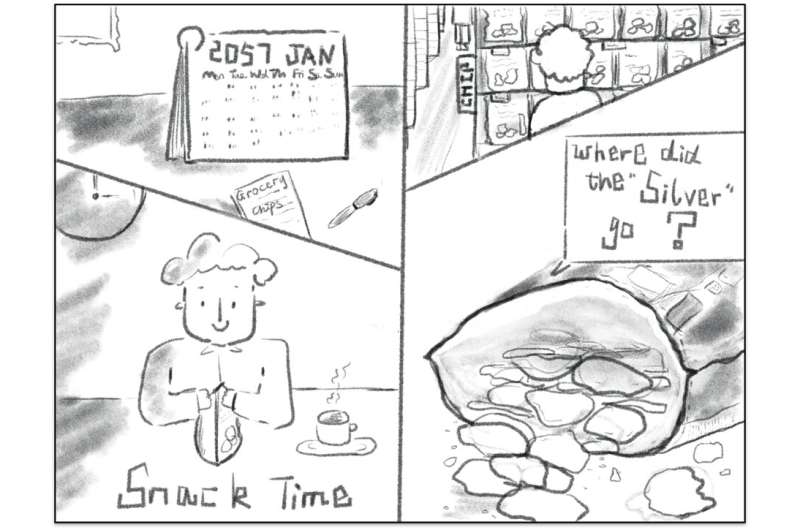Comic made by Jiaying Li
If it is up to UT-Ph.D. student Jiaying Li, we will no longer have a 'silver' layer in food packages like crisps bags. In her latest publication, she describes a relatively easy method to create recyclable coatings for food packages. Her research paves the way for food packages that—given the right conditions—can be recycled in water. She recently published her work in the scientific journal ACS Applied Materials & Interfaces.
If you're a potato crisps lover, you've probably noticed that most crisps bags have a 'silver' inner layer. While not really silver, but aluminum-based, this layer protects the crisps from oxygen in the air, preserving their crunchiness and preventing it from going bad. However, this layer makes it incredibly hard to recycle the bag. This is why most crisps bags end up incinerated, on landfills or in nature.
Multi-layered problem
The thin layer of packaging is actually multi-layered, existing of different materials—each with their own function—laminated together. These layers are hard to separate, making them difficult to recycle. Li is working on a solution in which the multiple materials are replaced by a single layer that performs more than one functionalities in order to reduce the number of layers. "This is already possible with polymers, but traditional polymers are hard to recycle and only soluble in organic solvents", explains Li.
Polyelectrolyte-based coatings
Polyelectrolyte-based coatings are the solution, according to Li. These coatings can be used as an oxygen barrier and—by introducing the right conditions—are dissolvable in water. "They are not new. However, similar to lasagne, these coatings have to be built layer by layer. Every layer of this lasagne takes around 30 minutes to make making it difficult to industrialize", says Li. Li's method reduces the time needed significantly, by preparing a liquid with both positively- and negatively-charged polyelectrolytes and blocking their interaction. When the drying starts, the liquid starts to form a dense layer that serves as a protective layer.
For the future
At this moment, this method is proven to work for the synthesized polyelectrolytes. The next goal is to use bio-derived polyelectrolytes. These polyelectrolytes are 100% natural-based, for example, extracted from shrimp shells or trees. All of this, hopefully, leads to a future without 'silver' in our crisps bags.
The article is titled "Single-Step Application of Polyelectrolyte Complex Films as Oxygen Barrier Coatings."
More information: Jiaying Li et al, Single-Step Application of Polyelectrolyte Complex Films as Oxygen Barrier Coatings, ACS Applied Materials & Interfaces (2021). DOI: 10.1021/acsami.1c05031
Journal information: ACS Applied Materials and Interfaces
Provided by University of Twente





















